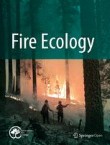Fire Ecology is the official journal of the Association for Fire Ecology.
Opportunities for winter prescribed burning in mixed conifer plantations of the Sierra Nevada
Young, planted forests are particularly vulnerable to wildfire. High severity effects in planted forests translate to the loss of previous reforestation investments and the loss of future ecosystem service gai...
